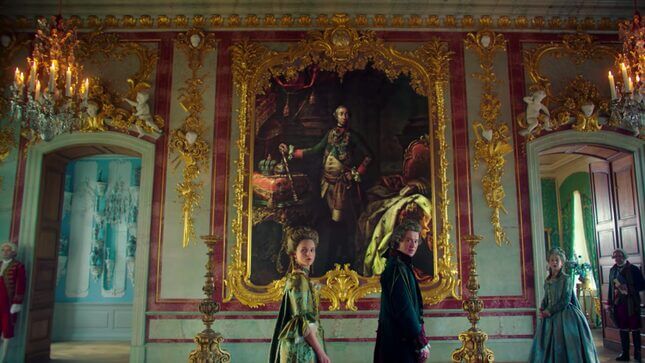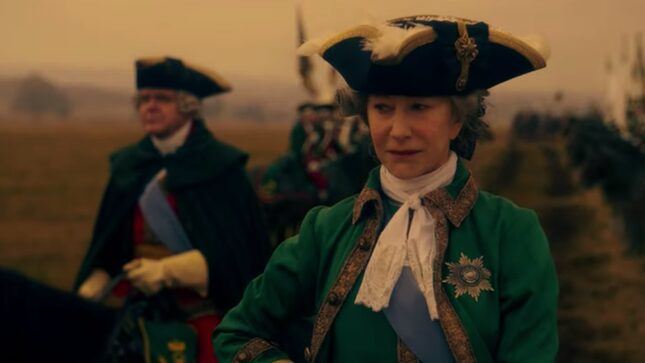
There is perhaps no purer illustration of the term “costume porn” than a miniseries about Catherine the Great, starring Helen Mirren. On Monday night, HBO premiered a four-part limited series on the glory days of the famous Russian empress—or maybe infamous is a better way to put it. The costumes are appropriately show-stopping, which is fitting, considering that over-the-top luxurious clothing is a time-honored means of all-powerful rulers flexing their might and majesty. For a figure like Catherine the Great, lavish clothing isn’t just a perk; it’s a tool.
In advance of the show, I spoke to Catherine the Great’s costume designer, Maja Meschede, about the production. We talked about what makes an 18th century court costume look Russian, whether they cheat and tuck velcro into all those elaborate gowns, and what happens to the clothes once the production packs up and goes home. Our interview has been condensed and lightly edited.
JEZEBEL: What drew you to the production? 18th century costume—especially 18th century imperial Russian costume!—is a big project and very specific. What drew you to the job?
MAJA MESCHEDE: Well, first of all, I love the director, Philip Martin. I’ve always admired his work, and I was just really thrilled when he asked me to come onboard. Secondly, 18th century Russia is just so splendid, and it’s very different to the 18th century court of France or England or any other continental court at the time. It’s very, very different in terms of style and colors, and I was really excited to explore and research.
What was the biggest challenge or the hardest part of outfitting this specific and this large of an 18th century costume production?
The big challenge was that we really had a very short amount of time. We were producing this in Lithuania, in Vilnius, and we had basically from July to the beginning of September to make about 60 different costumes for Helen Mirren alone. It’s not a big-budget production. I think we created about 3,000 different styles of costume for the whole show, and I think people worked really hard and everybody created something really wonderful and special.
We needed to think through the essence of what makes people look Russian. Why do people on Russian portraits look so different from portraits being painted in England by Gainsborough for example?
How do you decide how much of it you have to make? Can you rent part of it? Is there a company that you can go to and say, “We need 300 pairs of shoes?” Or do you really have to make the whole production from scratch?
We didn’t make everything from scratch. For most of the principle actors, we made everything from scratch. We also hired costumes, of course, in Italy. In Rome especially, there are beautiful costume houses where you can get the most amazing 18th century costumes. As I’ve said before, 18th century Russia is very different to the courts of England or, let’s say, France and Germany, and therefore it’s so specific that it had to be made, to actually tell the story in the way we wanted to tell it and portray the characters to be really, truly Russian. We needed to think through the essence of what makes people look Russian. Why do people on Russian portraits look so different from portraits being painted in England by Gainsborough, for example?
It gives you a lot of control. The color palette was really important. For Helen Mirren, there were lots of beautiful pastoral blue colors, shades of gold, silver. And there’s the army of Catherine the Great—they’re called the Preobrazhensky Guard, they are her imperial guard—and we dyed fabric a very specific red, a very specific green, just to make sure we portray the story as well as we could, to be as authentic as possible.

What were specifically the design elements you wanted to pull on to tell that story? What did you pick out, and what did you find are the details that make her look like Catherine the Great as opposed to whatever aristocratic English woman running around?
Toward the end of the 18th century, Catherine the Great introduced a court dress—she basically mixed French court dress with Russian peasant style. So if you look at portraits of Catherine the Great from, let’s say 1760s onward, you see the sleeves of her dresses are ruched. That’s based on the Russian peasant costumes. There’s also a beautiful braid running across the center front of her corset, in the center front of her dress, and that braid is also based on basically what Russian peasants wore for Sunday mass. When they went to church, they wore very elaborate, beautifully handmade clothes where you can see beautiful braids, the ruched sleeves, embroidery that is a specific style as well. And then the color palette is very specific. Call it the Russian blues, mixed with gold and then a specific green shade.
You said you had to make a signifiant number of specific costumes in a limited timeframe. Tell me about the setup where you made the costumes. How did you guys get the work done in time?
I had about two months just to do research prior. I started very early. I just did as much research as I could. Then we moved our team, my assistant designers, to Vilnius, in Lithuania, where we set up a workshop of very talented Lithuanian seamstresses and embroiders and ladies and gentlemen who were painting the costumes and breaking them down. And apart from Helen Mirren, Jason Clarke, and Gina McGee, most actors were called quite late. So you kind of know what you want to design and put together, but until you meet the actor or actresses in real life, that’s when it starts. And of course, there’s never enough time, so we make it work. We all pull together and work very long hours. But I think it’s worth it, putting all this energy in it, and it’s also fun to embroider the costumes. There’s always a very, very short deadline, when I do costumes, for the ones that we make. You just have to deal with the time that is given, and hope you get it done in time! Everyone was very passionate, though.
We made the corsets for all our ladies, and we made them really comfortable, so there’s a bit of elastic in the side seam so everybody can actually breathe.
I will say, I’ve never talked to a costume designer who was like, “You know, it was great, we had a ton of extra time, we were just sitting around relaxing.”
It’s so funny, I was just having this conversation with my supervisor on a sci-fi production at the moment, right next to Catherine the Great—also fun. I was just saying, we really don’t know what it is, every time, no matter how much we plan everything in advance; no matter how prepared we are, everything is always last minute. But it somehow always magically happens. I think it’s important to be very passionate about this job and have a good sense of humor.
If you had to pick a favorite piece, what was it?
One of my favorite pieces we created is for Helen Mirren, where Catherine the Great read out the reformations of Russia. It’s a very special dress because the fabric was specially made for us, specially woven. I designed the fabric, and it was woven in India, and then a team of 15 men and women embroidered the dress. There’s a lot of pearl embroidery on it, and there’s a little secret to the dress—in the center back of the over-robe, we embroidered Helen Mirren’s initials, HM, as an homage to Helen Mirren, our empress. She really loved it, she was so happy and very excited. So if you watch closely, you can actually see it.
Doing a project like this, can you use shortcuts? Are there zippers and velcro underneath? Or does everything have to be period authentic?
You know, as long as the camera doesn’t see it, we’re always happy to cheat and to cut corners. We made the corsets for all our ladies, and we made them really comfortable, so there’s a bit of elastic in the side seam so everybody can actually breathe. And for the corsets, which are underneath the main corsets—there’s the corset that you can see that’s part of the main dress and whatever’s underneath—yes, there is a zip. But for the top layer that we all can see, I wouldn’t use zips. I try to be as authentic as possible, to tell the story as truthfully as possible, but whenever needed, there’s double-sided tape; there’s safety pins. So yes, we do cheat. It saves time.

I’m sure nobody has the money to make actual whalebone corsets for everybody in a costume drama.
Well, as I say, the principle actresses, we made them. When a corset does not fit properly, it really hurts in the armpit; it really hurts on your hipbone and can be really, really painful to wear. But what’s good, when you wear a corset, the way a woman holds herself, her posture is so different. Like Helen and Gina, it really helped them to get into character, and it helped them feel what it felt like to be a woman in the 18th century. For the crowd, all the extras, we hired all the corsets, of course, but they weren’t in them every day from morning to evening. So you can get away with it if they don’t fit so exactly.
Is there a giant costume warehouse somewhere that everybody goes to? What’s that like?
Yeah! Well, as I said, for 18th century, the best place to go is Rome. My favorite house is Tirelli, or Peruzzi, or Costumi d’Arte, to just name three. It’s really spectacular, because they are collections of beautiful costumes from Fellini and amazing movies. There are thousands of costumes, skirts, dresses, overalls, corsets, and then you’ve got another costume store—there’s one called Pompei, who makes shoes made to measure, but you can also hire shoes, already made. Then there’s an amazing milliner in Rome who makes hats. You just send a drawing over, email or go there personally, and they make the most beautiful hats, but at the same time they already have a huge selection of thousands of hats. Because these costume hire places have existed, some of them, for a hundred years, so their collections are just astonishing. They’re like museums. Some costumes are up to a hundred years old. Really, I love going there. It’s like going treasure hunting.
It’s so wild to think there’s just a giant room somewhere in Rome that has a hundred years’ worth of costumes!
And you know, the costume house called Tirelli, it’s the former house of Marcello Mastroianni. His old villa. And there is a fitting studio so you can sit, you know, Helen Mirren in one of the studios, and then they have more warehouses outside of Rome. But I thought it’s really spectacular to be in Marcello Mastroianni’s house, working there.
You make all these costumes. They’re custom-fitted to Helen Mirren or somebody specific. After you shut down production, what do you do with all these costumes?
Well, at the moment, some of these costumes go to exhibitions. And then, very often these costumes get bought up by costume houses like Tirelli or Angels in London. There’s a costume house in Madrid which is also huge, thousands of costumes. Basically these companies buy the costumes and they’re recycled, which I think is very important, thinking about our planet. Maybe trimming gets taken off and something else gets put on.